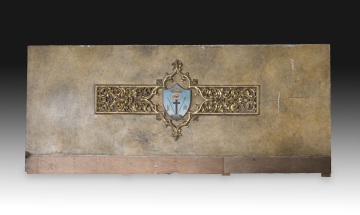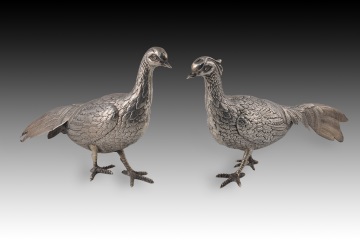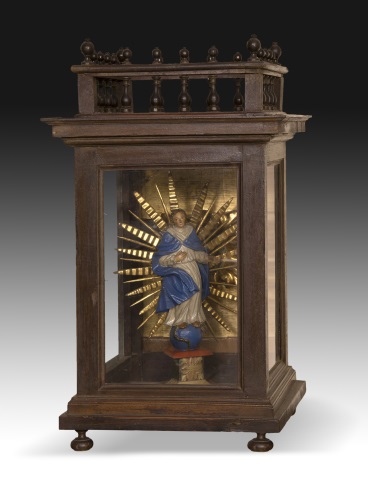
-
Set of six pillars. Carved wood, stone base. India, 19th century. Row of six carved wooden pillars with capitals at the top and carved stone bases at the bottom (grouped in pairs). The shafts have three different sections (square, polygonal and spiral) and relief decoration along them, consisting of plant elements, lines, simple architectural motifs, smooth areas, geometric shapes, etc. The capitals have a certain reminiscence of Western classical forms in their composition and decorative elements. This type of architectural element was, for example, very often used in the “havelis” (urban residences or traditional mansions) in India, Pakistan, Nepal and Bangladesh, with the usual differences depending on the geographical area, the date and the owner’s taste, but also in other notable buildings. Stone bases: 28x56x27 cms.
· Size: 169x25x213 cms. bases piedra 57x29 cms
DECORATIVE ANTIQUES
MISCELLANEUS
Ref.: AB002
-
Columns. Carved stone. 19th-20th centuries. Carved stone columns with symmetrical bases and capitals (formed by different smooth mouldings), with fluted shafts and decorated at the ends with shapes reminiscent of leaves, resembling certain elements of ancient Egyptian architecture. These types of elements were highly valued for prominent houses. Available 4 pcs.
· Size: 51x51x199 cms, / 46x46x188 cms.
DECORATIVE ANTIQUES
MISCELLANEUS
Ref.: AC051
-

Altar front or antipendium, shield of the Congregation of the Most Holy Redeemer. Plaster or stucco. 19th-20th centuries. Altar frontal made of plaster or stucco, with a finish resembling stone, except for the central piece. This rectangular strip has a gold finish and a fine relief with leaves clearly reminiscent of Gothic, leaving a square in the centre with lobes on the inside and plant details on the outside; this square houses a polychrome shield. The coat of arms used by the Congregation of the Most Holy Redeemer (Redemptorists) is a derivation of its seal, defined in its statutes of 1764. On a blue background, there are three mountains, with the cross flanked by a lance and a sponge on a stick and the abbreviated names of Jesus (IS intertwined) and Mary (AM intertwined); above the Latin cross, an eye with luminous rays; above all these elements, an open crown. This Congregation was founded in 1732 by Saint Alphonsus Maria de Liguori in Scala (Italy), and approved by the Vatican in 1749. In Madrid, the construction of the Parish Sanctuary of Perpetual Help in neo-Gothic style by the architect and Redemptorist brother Gusttave Knockaert was of great importance (thus, Neo-Gothic being the most common style in the Congregation during the second half of the 19th century, above all).
· Size: 120x5x59 cms.
DECORATIVE ANTIQUES
MISCELLANEUS
Ref.: Z0165B
-
Tuft. Metal. 19th century. Set of three metal pieces that, when joined together, would form a crest. The scrolls, plant motifs, palms, lines, etc. link these parts with 19th century works of clear Neoclassical influence, being similar to French works or those of schools with a strong French influence.
· Size: central 23x30 lateral: 40x23 cms
DECORATIVE ANTIQUES
MISCELLANEUS
Ref.: Z0165G
-
Sold

· Size: 21x5x13 cms.
DECORATIVE ANTIQUES
MISCELLANEUS
Ref.: Z0165N
-
Tray with handle. Silver-plated metal. Circa 1900. With contrast marks. Tray with lobed contours and three spaces inside and a border of pearls on the edge. It also has a handle that divides its axis in two and is decorated with plant and architectural elements with a clear classicist influence. It has three leaf-shaped legs. The contrasting marks are on the edge.
· Size: 34x34x15 cms
DECORATIVE ANTIQUES
MISCELLANEUS
Ref.: Z0165P
-
Bronze candlestick. 19th century. It is missing. Candlestick made of bronze with a mixtilinear base and simple decoration, a balustrade-shaped shaft with mouldings and a disc in the centre with curved profiles and a lighter finished in waves, resembling a flower. Weight: 300 grams.
· Size: 11x11x20 cms.
DECORATIVE ANTIQUES
MISCELLANEUS
Ref.: Z0165X
-
Twelve handles. Cast iron. 20th century, inspired by antique models. Set of twelve handles composed of one part decorated with simplified plant elements, and another that hangs from the previous one by means of a ring and has a balustrade shape.
· Size: 3x2x10 cms.
DECORATIVE ANTIQUES
MISCELLANEUS
Ref.: Z0205B
-
Chest corner pieces. Wrought iron. 20th century, following Renaissance models. Corner piece for the lower area of a chest made of wrought iron and decorated at the ends with fleur-de-lis shapes with a pointed top and cut edges, following common models in Renaissance works. Weight: 0.123 kg. Price per unit. Minimum 4 units
· Size: 15,5x9x6,5 cms.
DECORATIVE ANTIQUES
MISCELLANEUS
Ref.: Z0210C
-

Chapel of the Immaculate Conception. Sculpture, carved wood, glass, metal. Second half of the 18th century. A carved wooden chapel with decoration on the upper part of the railing and balusters in the shape of a vase reminiscent of the Baroque, which has three of its four fronts in transparent glass and stands slightly on circular legs. Inside, one can see a gold background (on the fourth front of the chapel, highlighting a carved and polychrome plant composition), and a polychrome sculpture of the Immaculate Conception surrounded by alternating flat and wavy and pointed and circular rays of light. The carving stands on a pedestal, and has a white tunic and a blue cloak; Mary stands on the Orb of Creation, in which a snake appears (linked to Sin). The carving shows a clear influence from Spanish Baroque models, as well as certain details such as the posture that can be linked to Neoclassicism. This mixture and the maintenance of the Baroque influence are common in 18th century Spanish sculpture.
· Size: 38,5x38x65 cms virgen
DECORATIVE ANTIQUES
MISCELLANEUS
Ref.: Z0252
-
"
· Size: 8x8x37 cms.
DECORATIVE ANTIQUES
MISCELLANEUS
Ref.: Z0254
-
"
· Size: 100x40x75 cms.
DECORATIVE ANTIQUES
MISCELLANEUS
Ref.: Z0281
-
"
· Size: 75x22x67
DECORATIVE ANTIQUES
MISCELLANEUS
Ref.: Z0285
-
Modernist style table clock. Tin alloy. Silver table clock consisting of an “L” shaped base decorated with a lady holding up the dial, which has Arabic numerals for the hours and dots for the minutes, and a series of branches emerging from it. The prominence of nature and the feminine, the curves of the figure and its position, etc. are inspired by modernist examples from around 1900.
· Size: 8x7x15 cms.
DECORATIVE ANTIQUES
MISCELLANEUS
Ref.: Z0323
-
Large candle. Silver-plated metal. 19th century. Table candle with a circular base and a column-shaped stem that is narrower at the bottom. The circular body of the piece, decorated with fine mouldings, has an upward decoration (in which a handle is inserted) with slight curves, a concave plate decorated with engraved lines and some clamps hanging from a chain. As is usual in 19th century art, it is inspired by styles of the past, adapting them to the taste of the moment.
· Size: 15x10x39 cms.
DECORATIVE ANTIQUES
MISCELLANEUS
Ref.: Z0324
-
Leontina, late 19th century. A leontina made up of six chains attached to a ring decorated with scrolls and small pendants, from which hang a series of objects and hooks for small items. The two longest ones end in an openwork plate with a ring for the watch. This type of “jewelry” was very common in the upper class, to carry pocket watches, the keys necessary for their operation and other small valuable objects.
· Size: 32 long. 34 cms. ancho
DECORATIVE ANTIQUES
MISCELLANEUS
Ref.: Z0334
-
Roman amulet “Fascinum”. Bronze. 1st-3rd centuries AD. c. Roman phallic amulet with a ring on one side to be worn around the neck as was customary. This type of piece, personification of the “divine phallus” in the mythology of Ancient Rome and the god Fascinus, invoked his protection and defended against evil. eye, being omnipresent in Roman culture due to their apotropaic power (they were worn by children to protect them, by the military, etc.).
· Size: Long. 3 cms.
DECORATIVE ANTIQUES
MISCELLANEUS
Ref.: Z0345
-
Roman amulet “Fascinum”. Bronze. 1st-3rd centuries AD. c. Elongated Roman phallic amulet with a ring on one side to be worn around the neck as was customary. This type of piece, personification of the “divine phallus” in the mythology of Ancient Rome and the god Fascinus, invoked his protection and defended against evil. of the eye, being omnipresent in Roman culture due to their apotropaic power (they were worn by children to protect them, by the military, etc.).
· Size: Long 3,5 cms.
DECORATIVE ANTIQUES
MISCELLANEUS
Ref.: Z0346
-
Incense burner. Bronze. 19th century. Bronze censer with a circular base and cup-shaped lid with elaborate lines and simple openwork elements, inspired by antique pieces. It has metal chains that connect it to the usual piece with a ring. Certain lines and decorative motifs are reminiscent of some Spanish works from the 17th and 18th centuries.
· Size: 10x10x16 cms.
DECORATIVE ANTIQUES
MISCELLANEUS
Ref.: Z0351
-
Oak clothes press, Holland, 19th century. A clothes press with a lockable cabinet at the bottom, made of oak wood in Holland. As is normal for these utilitarian items, it is not decorated and was used to smooth clothes. It is not common to keep this type of object because they were very frequently thrown away once better technical innovations became available. Oak wood was chosen for its construction due to its hardness and resistance.
· Size: 76x52x171 cms.
DECORATIVE ANTIQUES
MISCELLANEUS
Ref.: Z0368
-
Oak clothes press, Holland, 19th century. The press stands on four turned legs (three of which are secured with a straight jamb) with a drawer underneath. Being a purely utilitarian piece of furniture, it has hardly any decorative elements. The oak wood used in its manufacture was chosen for its hardness and resistance, since these presses were used to smooth clothes as much as possible.
· Size: 72x55x167 cms.
DECORATIVE ANTIQUES
MISCELLANEUS
Ref.: Z0369
-
Writing desk. Bronze. 19th century. The four containers that make up the writing case are placed on a tray with curved profiles decorated with mouldings and scallops on its edges. The sandbox or sandpit, the feather duster and the inkwell have clear lines and smooth areas, combined with fine mouldings resembling a cord; the oval box with a lid finished in a knob has smooth mouldings on its entire outer surface. Although certain details (particularly the tray) could be reminiscent of certain Rococo works of the 18th century, the toned down movement of the tray, the decoration of the containers, the lines and the lack of prominent decorative elements would be more characteristic of the Neoclassicism of the 18th and 19th centuries, as is the inspiration in styles of the past and the combination of various currents in the same piece.
· Size: 25x18x11 cms.
DECORATIVE ANTIQUES
MISCELLANEUS
Ref.: Z0376
-
Lamp part. Silver-plated metal. 20th century. Originally a piece that was part of a lamp made of silver-plated metal and decorated with elements inspired by classical art. The leaves, bands, strings of pearls, faun heads, scrolls, etc. that it features are clearly inspired by older neoclassical works of French influence.
· Size: 36x36x27 cms.
DECORATIVE ANTIQUES
MISCELLANEUS
Ref.: Z0387
-
Sculpture in corrugated iron. Signed “Aug. Moreau”. Following models by Auguste Moreau, France, 19th century. It is reminiscent of works such as the bronze “The Fountain” by Mathurin Moreau, and pieces by Hyppolyte Moreau and Auguste Moreau (France, 1834 – 1917). Auguste began his training as a disciple of his older brother Mathurin. He made his debut at the Paris Salon of 1861, where he participated regularly until 1913. He was also a member of the Société des Artistes Français. His themes – genre scenes, pastorals, allegorical – and his realistic and graceful style link him with other members of the Moreau dynasty, known for their small bronze works that were widely reproduced and inspired many other masters, both during the artists’ lifetime and after their death.
· Size: 18x18x52 cms.
DECORATIVE ANTIQUES
MISCELLANEUS
Ref.: Z0388